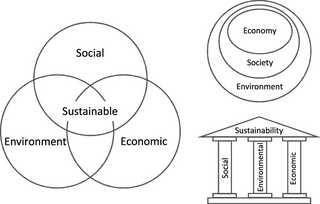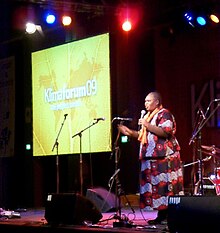
Natural capital is the world's stock of natural resources, which includes geology, soils, air, water and all living organisms. Some natural capital assets provide people with free goods and services, often called ecosystem services. All of these underpin our economy and society, and thus make human life possible.
The carrying capacity of an environment is the maximum population size of a biological species that can be sustained by that specific environment, given the food, habitat, water, and other resources available. The carrying capacity is defined as the environment's maximal load, which in population ecology corresponds to the population equilibrium, when the number of deaths in a population equals the number of births. The effect of carrying capacity on population dynamics is modelled with a logistic function. Carrying capacity is applied to the maximum population an environment can support in ecology, agriculture and fisheries. The term carrying capacity has been applied to a few different processes in the past before finally being applied to population limits in the 1950s. The notion of carrying capacity for humans is covered by the notion of sustainable population.

Environmental economics is a sub-field of economics concerned with environmental issues. It has become a widely studied subject due to growing environmental concerns in the twenty-first century. Environmental economics "undertakes theoretical or empirical studies of the economic effects of national or local environmental policies around the world. ... Particular issues include the costs and benefits of alternative environmental policies to deal with air pollution, water quality, toxic substances, solid waste, and global warming."
Environmental finance is a field within finance that employs market-based environmental policy instruments to improve the ecological impact of investment strategies. The primary objective of environmental finance is to regress the negative impacts of climate change through pricing and trading schemes. The field of environmental finance was established in response to the poor management of economic crises by government bodies globally. Environmental finance aims to reallocate a businesses resources to improve the sustainability of investments whilst also retaining profit margins.

Ecological economics, bioeconomics, ecolonomy, eco-economics, or ecol-econ is both a transdisciplinary and an interdisciplinary field of academic research addressing the interdependence and coevolution of human economies and natural ecosystems, both intertemporally and spatially. By treating the economy as a subsystem of Earth's larger ecosystem, and by emphasizing the preservation of natural capital, the field of ecological economics is differentiated from environmental economics, which is the mainstream economic analysis of the environment. One survey of German economists found that ecological and environmental economics are different schools of economic thought, with ecological economists emphasizing strong sustainability and rejecting the proposition that physical (human-made) capital can substitute for natural capital.
The ecological footprint measures human demand on natural capital, i.e. the quantity of nature it takes to support people and their economies. It tracks human demand on nature through an ecological accounting system. The accounts contrast the biologically productive area people use to satisfy their consumption to the biologically productive area available within a region, nation, or the world (biocapacity). Biocapacity is the productive area that can regenerate what people demand from nature. Therefore, the metric is a measure of human impact on the environment. As Ecological Footprint accounts measure to what extent human activities operate within the means of our planet, they are a central metric for sustainability.
A green economy is an economy that aims at reducing environmental risks and ecological scarcities, and that aims for sustainable development without degrading the environment. It is closely related with ecological economics, but has a more politically applied focus. The 2011 UNEP Green Economy Report argues "that to be green, an economy must not only be efficient, but also fair. Fairness implies recognizing global and country level equity dimensions, particularly in assuring a Just Transition to an economy that is low-carbon, resource efficient, and socially inclusive."

Ecosystem services are the many and varied benefits to humans provided by the natural environment and healthy ecosystems. Such ecosystems include, for example, agroecosystems, forest ecosystem, grassland ecosystems, and aquatic ecosystems. These ecosystems, functioning in healthy relationships, offer such things as natural pollination of crops, clean air, extreme weather mitigation, and human mental and physical well-being. Collectively, these benefits are becoming known as ecosystem services, and are often integral to the provision of food, the provisioning of clean drinking water, the decomposition of wastes, and the resilience and productivity of food ecosystems.

A carbon footprint (or greenhouse gas footprint) is a calculated value or index that makes it possible to compare the total amount of greenhouse gases that an activity, product, company or country adds to the atmosphere. Carbon footprints are usually reported in tonnes of emissions (CO2-equivalent) per unit of comparison. Such units can be for example tonnes CO2-eq per year, per kilogram of protein for consumption, per kilometer travelled, per piece of clothing and so forth. A product's carbon footprint includes the emissions for the entire life cycle. These run from the production along the supply chain to its final consumption and disposal.
Anthropogenic metabolism, also referred to as metabolism of the anthroposphere, is a term used in industrial ecology, material flow analysis, and waste management to describe the material and energy turnover of human society. It emerges from the application of systems thinking to the industrial and other man-made activities and it is a central concept of sustainable development. In modern societies, the bulk of anthropogenic (man-made) material flows is related to one of the following activities: sanitation, transportation, habitation, and communication, which were "of little metabolic significance in prehistoric times". Global man-made stocks of steel in buildings, infrastructure, and vehicles, for example, amount to about 25 Gigatonnes, a figure that is surpassed only by construction materials such as concrete. Sustainable development is closely linked to the design of a sustainable anthropogenic metabolism, which will entail substantial changes in the energy and material turnover of the different human activities. Anthropogenic metabolism can be seen as synonymous to social or socioeconomic metabolism. It comprises both industrial metabolism and urban metabolism.

Climate justice is an approach to climate action that focuses on the unequal impacts of climate change on marginalized or otherwise vulnerable populations. Climate justice wants to achieve an equitable distribution of both the burdens of climate change and the efforts to mitigate climate change. Climate justice is a type of environmental justice.

The following outline is provided as an overview of and topical guide to sustainability:

Sustainability is a social goal for people to co-exist on Earth over a long time. Definitions of this term are disputed and have varied with literature, context, and time. Experts often describe sustainability as having three dimensions : environmental, economic, and social, and many publications emphasize the environmental dimension. In everyday use, sustainability often focuses on countering major environmental problems, including climate change, loss of biodiversity, loss of ecosystem services, land degradation, and air and water pollution. The idea of sustainability can guide decisions at the global, national, and individual levels. A related concept is sustainable development, and the terms are often used to mean the same thing. UNESCO distinguishes the two like this: "Sustainability is often thought of as a long-term goal, while sustainable development refers to the many processes and pathways to achieve it."
An intact forest landscape (IFL) is an unbroken natural landscape of a forest ecosystem and its habitat–plant community components, in an extant forest zone. An IFL is a natural environment with no signs of significant human activity or habitat fragmentation, and of sufficient size to contain, support, and maintain the complex of indigenous biodiversity of viable populations of a wide range of genera and species, and their ecological effects.

Earth Overshoot Day (EOD) is the calculated illustrative calendar date on which humanity's resource consumption for the year exceeds Earth’s capacity to regenerate those resources that year. The term "overshoot" represents the level by which human population's demand overshoots the sustainable amount of biological resources regenerated on Earth. When viewed through an economic perspective, the annual EOD represents the day by which the planet's annual regenerative budget is spent, and humanity enters environmental deficit spending. EOD is calculated by dividing the world biocapacity, by the world ecological footprint, and multiplying by 365, the number of days in a year:

Environmental issues are disruptions in the usual function of ecosystems. Further, these issues can be caused by humans or they can be natural. These issues are considered serious when the ecosystem cannot recover in the present situation, and catastrophic if the ecosystem is projected to certainly collapse.

Climate debt is the debt said to be owed to developing countries by developed countries for the damage caused by their disproportionately large contributions to climate change. Historical global greenhouse gas emissions, largely by developed countries, pose significant threats to developing countries, who are less able to deal with climate change's negative effects. Therefore, some consider developed countries to owe a debt to developing ones for their disproportionate contributions to climate change.

Climate finance is an umbrella term for funding investments in the area of climate change mitigation and adaptation. In a wider sense, the term refers to all financial flows relating to climate change mitigation and adaptation. In a narrower sense it only refers to transfers of public money from developed countries to developing countries. This would be in light of their obligations under the UN Climate Convention to provide new and additional financial resources.

A carbon budget is a concept used in climate policy to help set emissions reduction targets in a fair and effective way. It examines the "maximum amount of cumulative net global anthropogenic carbon dioxide emissions that would result in limiting global warming to a given level". It can be expressed relative to the pre-industrial period. In this case, it is the total carbon budget. Or it can be expressed from a recent specified date onwards. In that case it is the remaining carbon budget.

Ecological overshoot is the phenomenon which occurs when the demands made on a natural ecosystem exceed its regenerative capacity. Global ecological overshoot occurs when the demands made by humanity exceed what the biosphere of Earth can provide through its capacity for renewal.
















